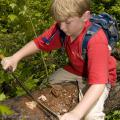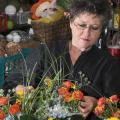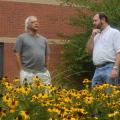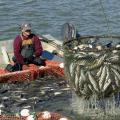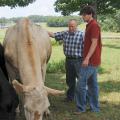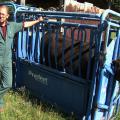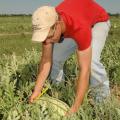Feature Story from 2009
MISSISSIPPI STATE – The top-notch security team at the National Governors’ Conference includes canine members, and Mississippi State University’s College of Veterinary Medicine was on hand to lend them support.
CVM’s Disaster Animal Response Team works with the Mississippi Board of Animal Health’s Mississippi Animal Response Team to provide emergency care and services to animals around the state. The team gives support to companion animals and sometimes livestock during and after disasters such as hurricanes. They also participate in large events involving pets or livestock.
By Patti Drapala
MSU Ag Communications
MISSISSIPPI STATE – Mississippi State University’s 4-H Entomology and Horticulture Camp is one of the few of its kind to offer overnight stay for nocturnal collecting, which attracts participants to the event just like moths to light.
“We introduce campers to the technique of attracting night insects using black lighting, which opens up a new world for them,” said retired MSU Extension Service entomologist Mike Williams. “You could jokingly say we end activities with a last call for the appropriate type of alcohol.”
MISSISSIPPI STATE – The 20th annual KIDS COUNT Data Book was released this week and includes information on the needs and conditions of Mississippi’s children and families.
The book presents national and state data to determine the degree to which children and families benefit from and are supported by their local environments. The data helps each state determine how they are doing compared to other states and the nation as a whole. Data for Mississippi reveals that trends in child well-being have improved in some areas and declined in others since 2000.
MISSISSIPPI STATE – The University Florist has operated for most of its history in the heart of Mississippi State University, where it serves as both a full-time business and a design laboratory for students.
The University Florist began 75 years ago and predates the professional program by quite a few years.
MISSISSIPPI STATE – Mississippians with timberland in production are looking at carbon as a new source of income, and they are learning to manage their land for the most profit while participating in efforts to lower greenhouse gas levels.
Carbon dioxide, or CO2, often called simply carbon, is one of several chemical compounds known today as greenhouse gases, or GHG. These gases occur both naturally and as byproducts of fossil fuel use in various transportation and industrial processes.
MISSISSIPPI STATE -- A senior agriculture administrator at the University of Idaho is the new vice president for one of Mississippi State University's oldest academic units.
MSU President Mark Keenum announced Monday [Aug. 3] that Gregory A. Bohach is being named vice president for the Division of Agriculture, Forestry and Veterinary Medicine. His appointment is pending formal approval by the Board of Trustees, State Institutions of Higher Learning.
By Patti Drapala
MSU Ag Communications
MISSISSIPPI STATE -- The Southeast has an opportunity to capitalize on the green movement, according to a Mississippi State University consumer survey.
Richard Harkess, an ornamental horticulture professor in the Department of Plant and Soil Sciences, and Robert Brzuszek, a landscape architecture professor in the Department of Landscape Architecture and Landscape Contracting, wanted to determine if the green movement is influencing the purchase and use of native plants.
MISSISSIPPI STATE – The state’s catfish industry is facing some major obstacles as producers are dealing with very high feed prices, declining acreage and fierce competition from imported fish.
John Anderson, Mississippi State University Extension Service agricultural economist, said the most significant influence on catfish prices since the fall of 2008 has been the condition of the overall economy.
MISSISSIPPI STATE – The Mississippi State University Extension Service 4-H program received a $10,000 grant to improve the state’s after-school programming by training 500 of its providers.
The MetLife Foundation and the National 4-H Council provided the grant. Mississippi was one of 11 states to receive the grant aimed at improving after-school programming offered across the state.
MISSISSIPPI STATE – Soybean rust was found in Mississippi in two fields near Thornton on Thursday, but experts are not recommending producers spray fungicide for the disease.
MISSISSIPPI STATE -- Mississippi State University and the U.S. Department of Agriculture-Agriculture Research Service are hosting a Muscadine Field Day Aug. 21 at the McNeil Experiment Station Vineyard which has been set up as a repository of muscadine varieties.
The field day is from 9 a.m. to noon. The vineyard is located at the McNeil Unit of the Mississippi Agricultural and Forestry Experiment Station in Pearl River County.
By Patti Drapala
MSU Ag Communications
MISSISSIPPI STATE – Corn-to-ethanol manufacturing has created huge amounts of a byproduct suitable as an ingredient in cattle feed, and Mississippi State University researchers want to know if a more refined version packs the same nutritional punch.
By Rebekah Ray
Delta Research and Extension Center
STONEVILLE — Consumers expect nothing less than the best from Mississippi’s pond-raised catfish industry, and this keeps researchers at Mississippi State University’s Delta Research and Extension Center conducting taste tests on the popular fish.
MISSISSIPPI STATE – Dreams often drive the will to live and the courage to endure, and one organization based at Mississippi State University is helping fuel these dreams for young people across the country who face life-threatening health conditions.
The Catch-A-Dream Foundation is a non-profit organization that provides special hunting and fishing expeditions to young people age 18 and under with a disease or condition that will become terminal if not cured or interrupted. Marty Brunson is a professor with MSU’s Extension Service and director of the foundation.
MISSISSIPPI STATE -- For almost 25 years, a Winston County self-help cooperative has been doing what its name implies -- helping people help themselves -- by providing educational information and establishing partnerships with experts.
A partnership with Mississippi State University’s Extension Service and MSU’s College of Veterinary Medicine are an important part of the co-op’s monthly programs. The partnership also makes it easier for specialists to assist producers when needed. Such was the case when the co-op hosted a recent cattle field day for its members.
By Patti Drapala
MSU Ag Communications
OKOLONA -- Chickasaw County farmer Jay Schmidt wants to leave a lasting legacy for his four children, so slumping catfish prices and volatile row crop markets made him step outside his comfort zone to find a solution.
Jay has grown soybeans, corn and catfish for many years. He, his wife, Sonya, and their children, Andrea, 13; Dean, 15; Laura Beth, 10; and Emily, 5; have worked hard to make the farm a family operation.
MISSISSIPPI STATE -- Mississippi State University Extension Service specialists are hopeful that incidences of soybean rust across the state will continue to be minor and only occur after plants have passed the at-risk growth stage.
MISSISSIPPI STATE -- A research scientist with more than two decades of experience with cropping systems is the first recipient of an endowed chair in Mississippi State University’s Department of Plant and Soil Sciences.
Daniel B. Reynolds, a professor of weed science at MSU, has been named the first Dr. Glover B. Triplett Endowed Chair in Agronomy. The Triplett Endowed Chair recognizes major contributions to Mississippi State by Triplett and his wife Imogene.
MISSISSIPPI STATE -- What can be “greener” than Mississippi forests? Find the answer when Mississippi forests and their products are managed with all of the environment’s best interests in mind.
Glenn Hughes, Extension forestry professor at Mississippi State University’s College of Forest Resources, said a growing number of wood product and forest managers are seeking official “green” certification.
By Patti Drapala
MSU Ag Communications
MISSISSIPPI STATE – Abundant natural resources and a good infrastructure give Mississippi a competitive advantage as a major supplier of renewable energy, and Mississippi State University is conducting research and connecting with industry to help the state reach its potential.
Pages
Feature Story Archive
- 2025 (43)
- 2024 (116)
- 2023 (114)
- 2022 (112)
- 2021 (104)
- 2020 (140)
- 2019 (126)
- 2018 (141)
- 2017 (197)
- 2016 (240)
- 2015 (319)
- 2014 (355)
- 2013 (371)
- 2012 (343)
- 2011 (246)
- 2010 (236)
- 2009 (229)
- 2008 (188)
- 2007 (210)
- 2006 (199)
- 2005 (224)
- 2004 (215)
- 2003 (228)
- 2002 (176)
- 2001 (184)
- 2000 (188)
- 1999 (180)
- 1998 (178)
- 1997 (188)
- 1996 (58)
- 1995 (36)


